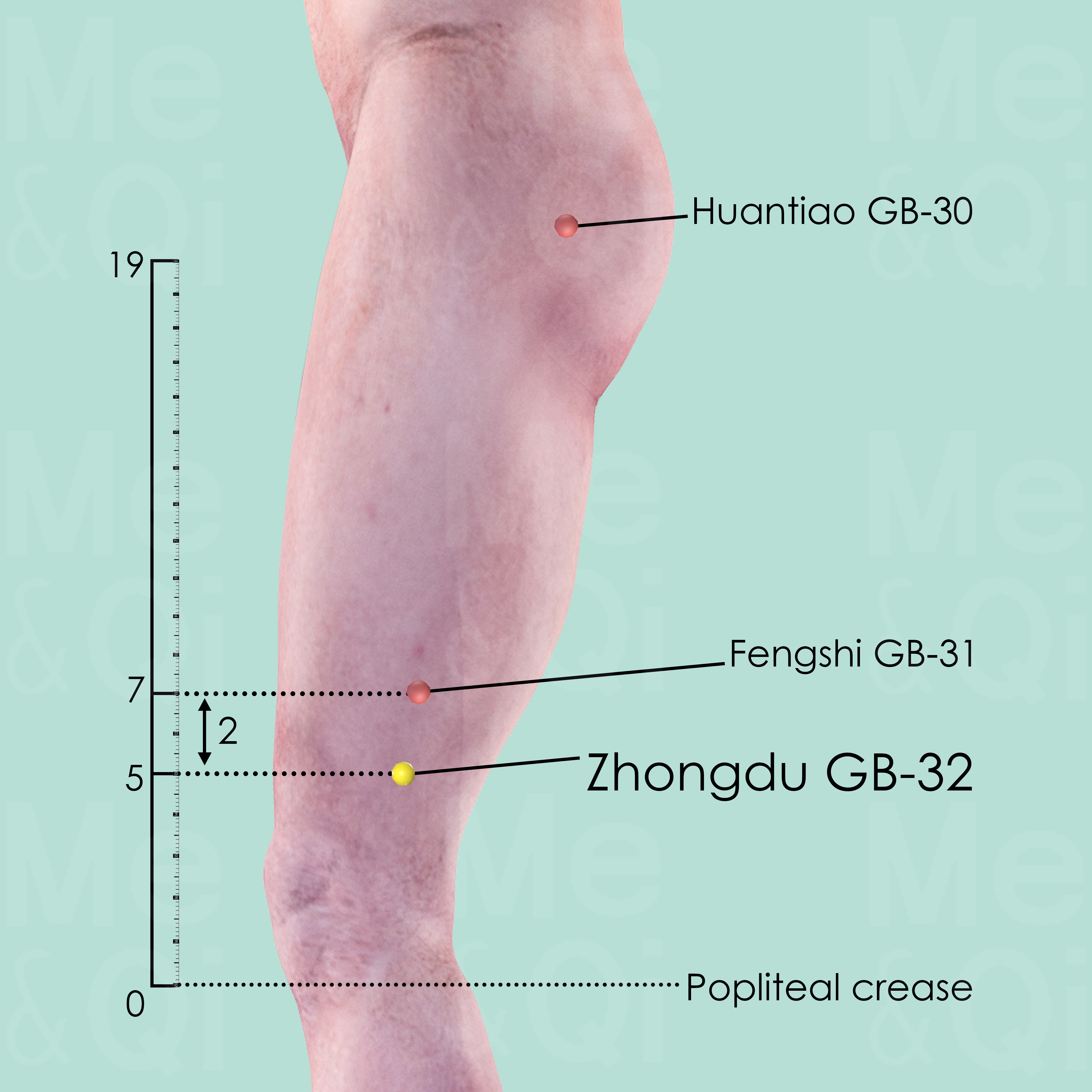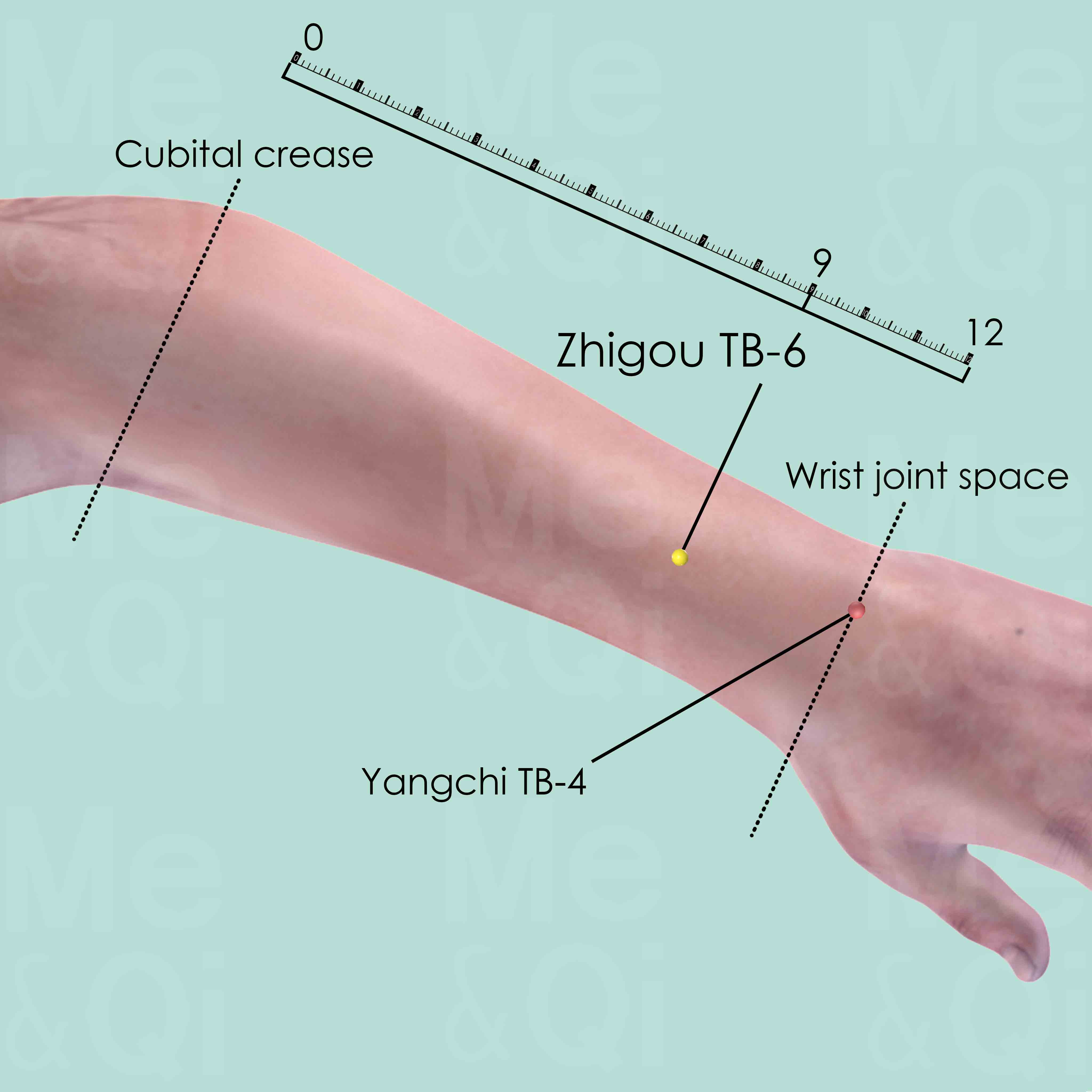Urticariaaccording to TCM
Symptom family: Skin Inflammation & Swelling
Sub-symptom(s): Chronic Urticaria
What is Urticaria?
Urticaria, commonly known as hives, is a skin condition characterized by red, itchy, raised welts that appear on the surface of the skin. These welts can vary in size and shape and can occur anywhere on the body. Urticaria can be triggered by various factors, including allergic reactions, stress, infections, or even exposure to cold or heat. Chronic urticaria, a form where symptoms persist for more than six weeks, poses a significant challenge to patients' quality of life, often requiring a deeper investigation into underlying causes.
How does TCM view Urticaria?
Traditional Chinese Medicine (TCM) views urticaria as a result of external pathogenic factors invading the body, leading to an imbalance between the body's defensive energy (Wei Qi) and the pathogenic factor. TCM categorizes urticaria based on underlying patterns of disharmony, such as Wind-Heat, or Blood Deficiency, each presenting with distinct symptoms.
Identifying the correct pattern is crucial in TCM, as it guides the treatment strategy to not only alleviate the symptoms but also address the root cause of the imbalance, aiming for long-term relief and balance restoration.
Root Causes of Urticaria in TCM
In the context of Traditional Chinese Medicine, urticaria is often linked to the interplay between Blood Deficiency and the invasion of External Wind. This specific pattern highlights a scenario where the body's nurturing and protective aspects are compromised, making the skin susceptible to irritations and reactions.
Blood Deficiency implies an insufficiency in the vital substances that nourish the skin, rendering it dry and itchy, while External Wind refers to pathogenic influences that trigger the sudden appearance of welts. Addressing this dual pattern is key in TCM, aiming to enrich the Blood and fortify the body's defenses to counteract the effects of Wind, thereby alleviating the distressing symptoms of urticaria.
Explore below more details about what might cause Urticaria according to TCM.
- By Syndrome
- Blood Deficiency
- Wind
Blood Deficiency
Blood Deficiency in TCM is like when your body's tank runs low on the vital energy that blood provides. It's not exactly the same as anemia in modern medicine, which is about having too few red blood cells. Instead, Blood Deficiency in TCM is about your body not having enough of the life-giving qualities that blood brings, like nourishment and moisture. This can make you feel tired, look pale, and even feel dizzy or have blurry vision. It's like a garden not getting enough water to stay lush and vibrant. TCM sees this as an imbalance where the body isn't being nourished as it should be, impacting overall health and well-being.... see more
Blood Deficiency Patterns That Can Lead to Urticaria
| Pattern Name | Relevant Symptoms | Relevant Formulas |
|---|---|---|
| Blood Deficiency with External Wind | Urticaria, Eczema, Red skin eruptions, Neurodermatitis, Ichthyosis, Psoriasis, Measles, Contact dermatitis, Itchy skin, Hair loss, Carbuncles, Boils, Drug rash, Skin dryness, Itching worsen at nights, Flaking skin... see more | Dang Gui Yin Zi |
Wind
In TCM "Wind" is a concept that represents a pattern of disharmony, often characterized by its sudden and unpredictable nature, much like a gusty wind changing direction without warning. This pattern is associated with symptoms that come and go quickly or move around the body, such as itching, tremors, or even certain types of pain. Wind is considered to be a primary cause of illnesses that have these rapidly changing characteristics. In TCM, external Wind often refers to illnesses that start suddenly, like the common cold, believed to be caused by external pathogenic factors like climatic changes. On the other hand, internal Wind can be linked to internal imbalances and can manifest in conditions like dizziness or spasms. ... see more
Wind Patterns That Can Lead to Urticaria
| Pattern Name | Relevant Symptoms | Relevant Formulas |
|---|---|---|
| Blood Deficiency with External Wind | Urticaria, Eczema, Red skin eruptions, Neurodermatitis, Ichthyosis, Psoriasis, Measles, Contact dermatitis, Itchy skin, Hair loss, Carbuncles, Boils, Drug rash, Skin dryness, Itching worsen at nights, Flaking skin... see more | Dang Gui Yin Zi |
TCM Herbal Formulas for Urticaria
To effectively manage urticaria rooted in Blood Deficiency with External Wind, TCM prescribes a holistic treatment regimen, incorporating both herbal remedies and acupuncture. The Dang Gui Yin Zi formula emerges as a pivotal remedy, enriched with herbs like Japanese catnip (Jing Jie) that adeptly dispel Wind while simultaneously supporting the Blood.
This therapeutic blend not only targets the visible manifestations of urticaria, such as itching and redness but also works on a deeper level to restore the body’s equilibrium. Complementing this herbal treatment, strategic acupuncture points like Fengshi GB-31 and Huantiao GB-30 are utilized to reinforce the body’s surface, making it more resilient against External Wind. This integrative approach embodies TCM's commitment to treating the individual as a whole, ensuring a path towards lasting relief from urticaria.
Explore below some TCM herbal formulas used to address urticaria, organized by cause and by formula type.
- By Cause
- By Formula Type
- Blood Deficiency
- Wind
- Formulas that clear wind-Cold
- Formulas that dredge and disperse external wind
- Formulas that invigorate blood and dispel blood stagnation
- External formulas for external disorders
- Formulas that nourish yin and tonify
- Formulas that warm and purge
- Formulas that warm the meridians and disperse cold
- Formulas that transform dampness and harmonize stomach
- Formulas that clear wind-Heat
- Formulas that tonify qi
- Formulas that promote urination and leach out dampness
- Formulas that clear heat from the organs
- Formulas that tonify yin and yang
- Formulas that nourish the heart and calm the mind
Top Formula for Blood Deficiency:
Dang Gui Yin Zi
Suitable for Blood Deficiency patterns that may cause urticaria, such as Blood Deficiency with External Wind
Learn moreTop Formula for Wind:
Dang Gui Yin Zi
Suitable for Wind patterns that may cause urticaria, such as Blood Deficiency with External Wind
Learn moreFormulas that dredge and disperse External Wind
These formulas are suitable for some urticaria-causing patterns like Blood Deficiency with External Wind.
One such formula is Dang Gui Yin Zi, with japanese catnip as a key herb.
Other formulas of this category are listed in the table below.
All "formulas that dredge and disperse external wind" recommended for urticaria
| Formula | Patterns Suitable For (if applicable) |
|---|---|
| Dang Gui Yin Zi | Blood Deficiency with External Wind |
| Xiao Feng San | Not applicable |
Formulas that clear Wind-Cold
Urticaria can be treated by these formulas when it stems from external pathogenic influences characterized by cold and wind symptoms.
One such formula is Jiu Wei Qiang Huo Tang, with notopterygium root as a key herb.
Other formulas of this category are listed in the table below.
All "formulas that clear wind-Cold" recommended for urticaria
| Formula | Patterns Suitable For (if applicable) |
|---|---|
| Jiu Wei Qiang Huo Tang | Not applicable |
| Ma Huang Tang | Not applicable |
| Gui Zhi Tang | Not applicable |
Formulas that invigorate Blood and dispel Blood Stagnation
Urticaria can be treated by these formulas if it arises from poor blood circulation or stagnation of blood, which often manifests in pain or swelling.
One such formula is Dang Gui Shao Yao San, with white peony root as a key herb.
Other formulas of this category are listed in the table below.
All "formulas that invigorate blood and dispel blood stagnation" recommended for urticaria
| Formula | Patterns Suitable For (if applicable) |
|---|---|
| Dang Gui Shao Yao San | Not applicable |
| Tao He Cheng Qi Tang | Not applicable |
External formulas for External disorders
Urticaria can be treated by these formulas if it is caused by external factors like wind, cold, or heat leading to symptoms on the body's surface.
One such formula is Jing Fang Bai Du San, with japanese catnip as a key herb.
Other formulas of this category are listed in the table below.
All "external formulas for external disorders" recommended for urticaria
| Formula | Patterns Suitable For (if applicable) |
|---|---|
| Jing Fang Bai Du San | Not applicable |
| Ren Shen Bai Du San | Not applicable |
Formulas that nourish Yin and tonify
Urticaria can be treated by these formulas when it arises from a deficiency in Yin energy, needing nourishment and strengthening of the body's vital essence.
One such formula is Ba Wei Di Huang Wan, with prepared rehmannia as a key herb.
Formulas that warm and purge
Urticaria can be treated by these formulas if it stems from cold accumulation coupled with excess conditions, necessitating warming and purging actions.
One such formula is Da Huang Fu Zi Tang, with prepared aconite as a key herb.
Formulas that warm the Meridians and disperse Cold
Urticaria can be treated by these formulas if it results from cold obstructing the meridians, leading to pain or stiffness, requiring warming and dispersing actions.
One such formula is Huang Qi Gui Zhi Wu Wu Tang, with milkvetch root as a key herb.
Formulas that transform Dampness and harmonize Stomach
Urticaria can be treated by these formulas when it is due to dampness affecting the stomach, leading to digestive disturbances.
One such formula is Huo Xiang Zheng Qi San, with korean mint as a key herb.
Formulas that clear Wind-Heat
Urticaria can be treated by these formulas if it originates from a wind-heat invasion.
One such formula is Jing Jie Lian Qiao Tang, with japanese catnip as a key herb.
Formulas that tonify Qi
Urticaria can be treated by these formulas if it results from Qi deficiency, necessitating treatments that boost the body's vital energy.
One such formula is Sheng Yang Yi Wei Tang, with milkvetch root as a key herb.
Formulas that promote urination and leach out Dampness
Urticaria can be treated by these formulas when it is caused by an accumulation of dampness in the body, requiring diuretic actions to promote fluid balance.
One such formula is Wu Pi Yin, with poria-cocos mushroom as a key herb.
Formulas that clear Heat from the Organs
Urticaria can be treated by these formulas if it stems from an excess heat condition in specific organs, leading to internal disharmony.
One such formula is Xie Bai San, with mulberry bark as a key herb.
Formulas that tonify Yin and Yang
Urticaria can be treated by these formulas if it stems from a deficiency in both Yin and Yang energies, necessitating a balanced approach to tonification.
One such formula is Shi Quan Da Bu Tang, with milkvetch root as a key herb.
Formulas that nourish the Heart and calm the Mind
Urticaria can be treated by these formulas when it stems from a disharmony between the heart and the mind, often manifesting as emotional disturbances or sleep issues.
One such formula is Tian Wang Bu Xin Dan, with unprepared rehmannia as a key herb.
Acupoints for Urticaria
TCM also incorporates acupuncture as a complementary treatment for urticaria, targeting specific acupoints to harmonize the body's Qi, nourish Blood, and expel pathogenic Wind and Heat. Points such as Fengshi GB-31 and Huantiao GB-30 on the Gall Bladder Channel are selected for their ability to expel Wind and relieve skin symptoms.
Additionally, Quchi LI-11 on the Large Intestine Channel is utilized for its Heat-clearing properties, providing a multi-faceted approach to treating urticaria by addressing both the symptoms and the underlying disharmony patterns, promoting a holistic recovery process.
Explore below some acupoints used to address urticaria, organized by meridian.
- By Meridian
- Gall Bladder Channel
- Large Intestine Channel
- Bladder Channel
- Extra Points: Back (EX-B)
- Spleen Channel
- Triple Burner Channel
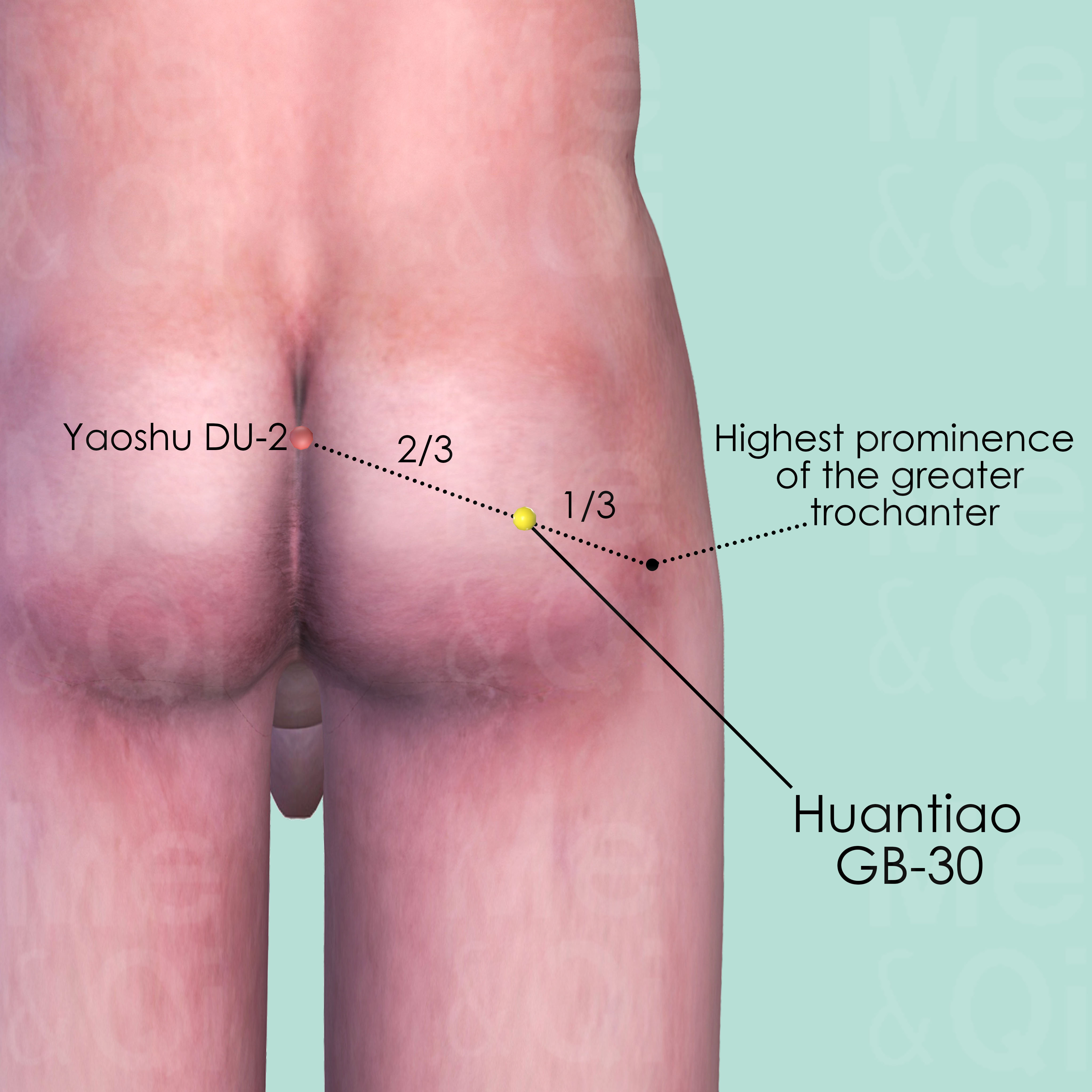
Huantiao GB-30
At the junction of the middle and lateral third of the distance between the great trochanter and Yaoshu DU-2 of the hiatus of the sacrum. When locating the point, put the patient in lateral recumbent position with the thigh flexed.
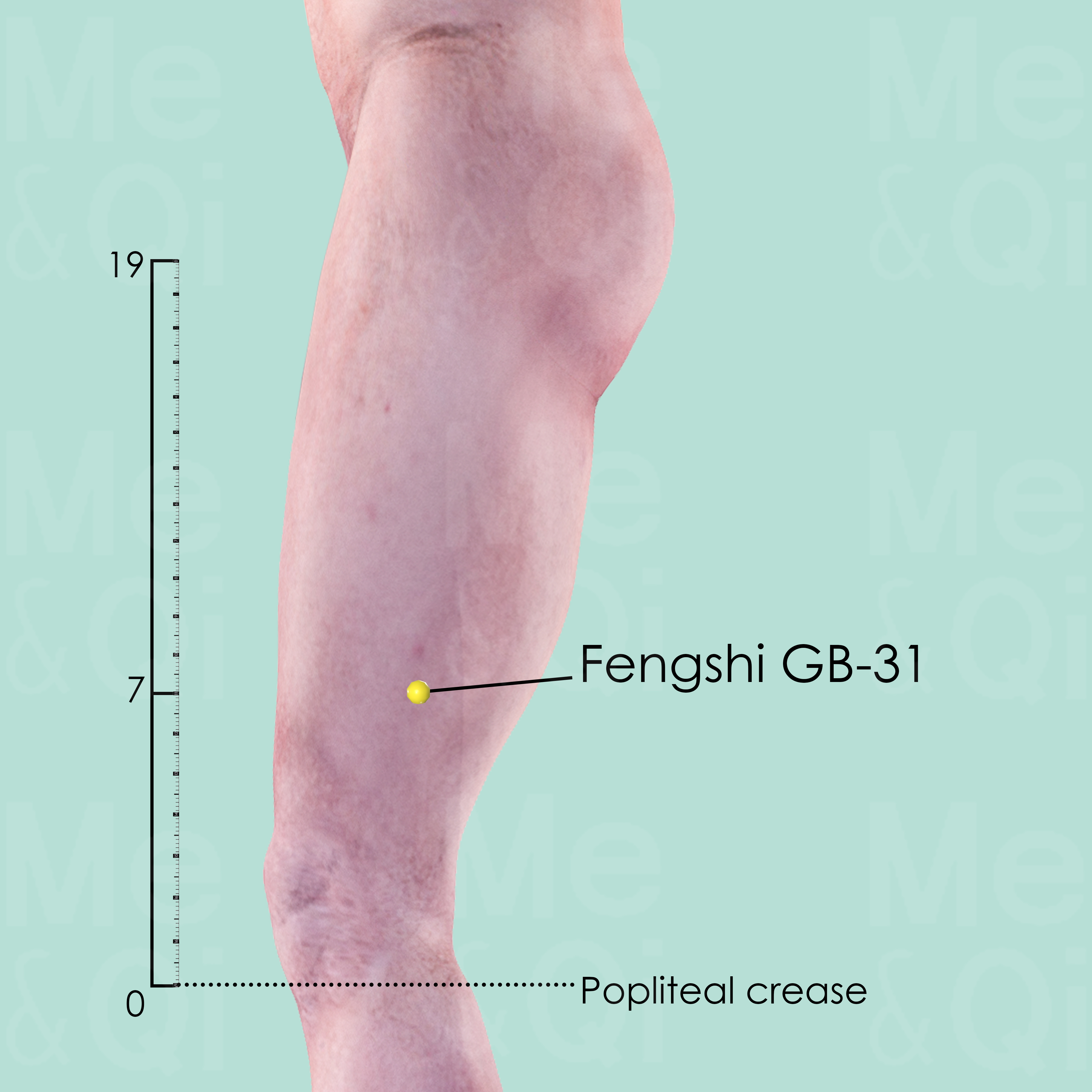
Fengshi GB-31
On the midline of the lateral aspect of the thigh, 7 cun above the transverse politeal crease.
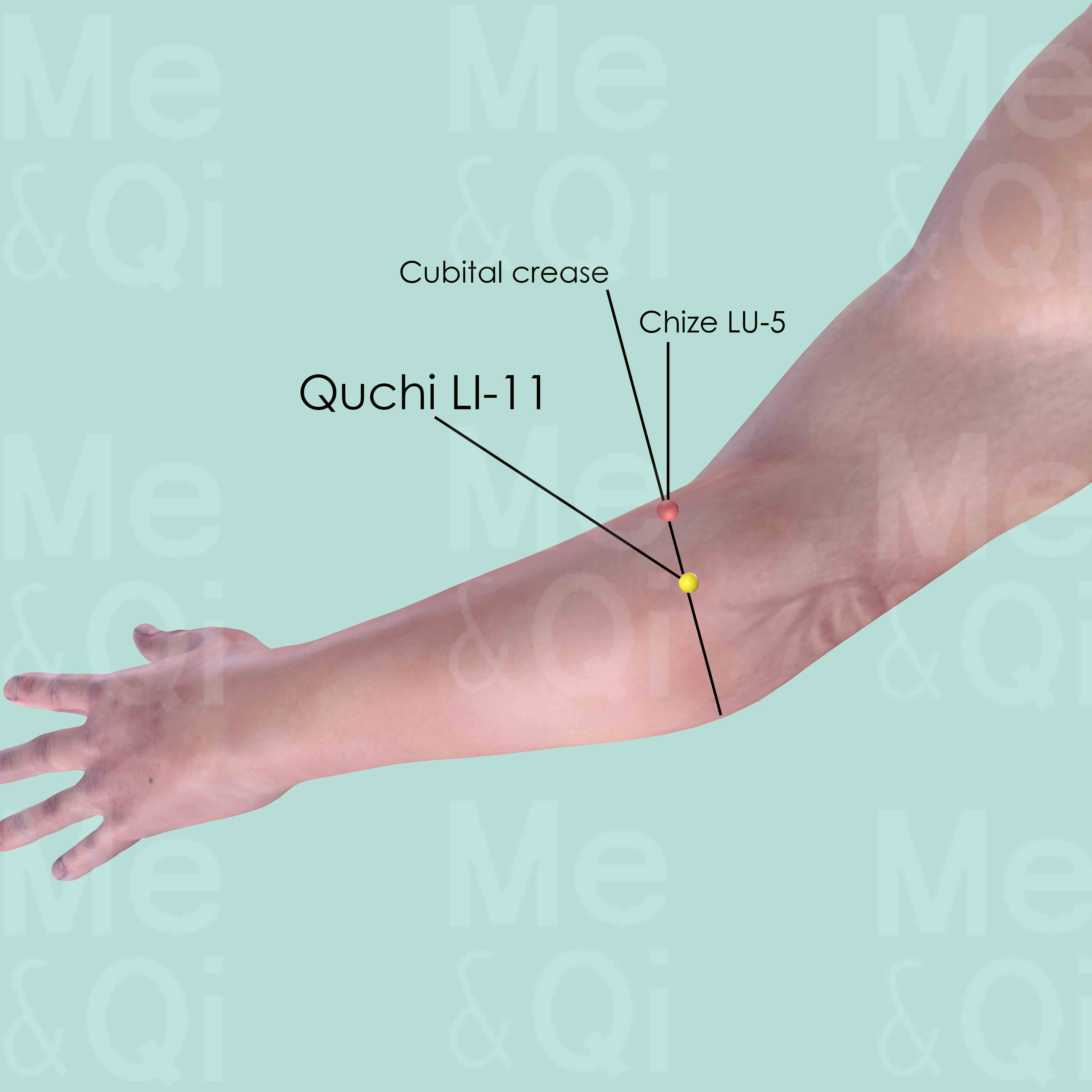
Quchi LI-11
When the elbow is flexed, Quchi LI-11 is in the depression at the lateral end of the cubital crease, midway between Chize LU-5 and the lateral epicondyle of the humerus.
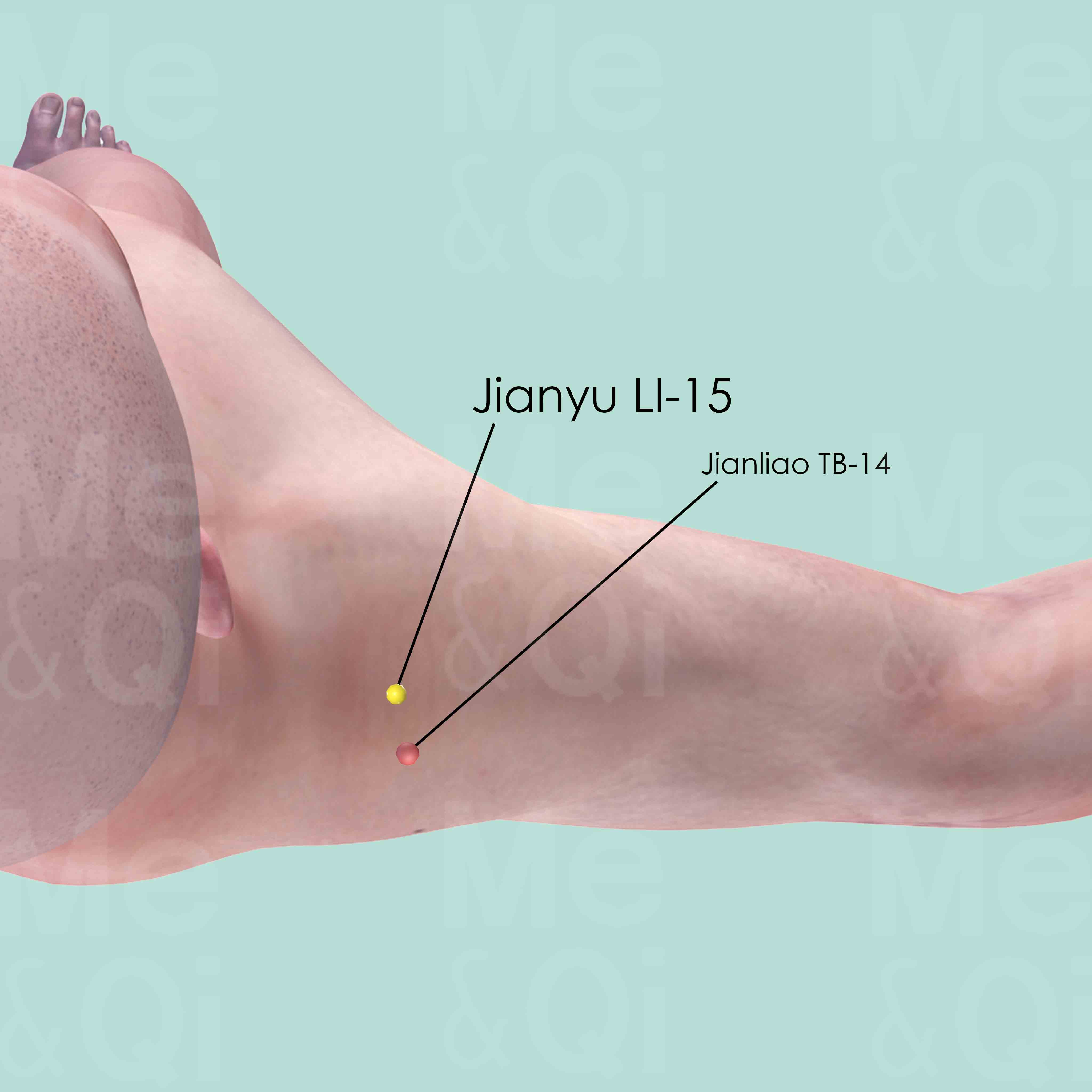
Jianyu LI-15
Jianyu LI-15 is located antero-inferior to the acromion, between the clavicular and acromial portions of the deltoid muscle.
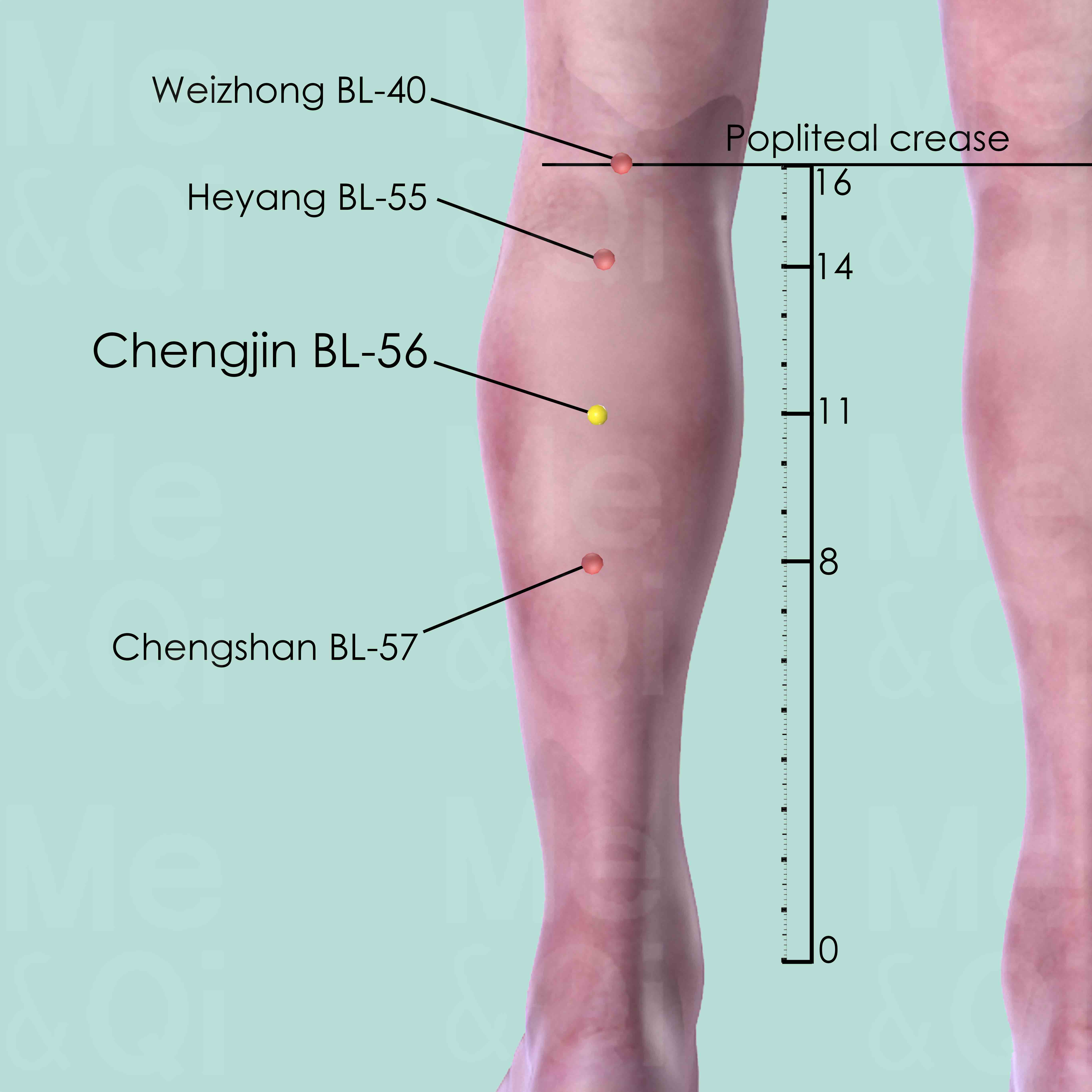
Chengjin BL-56
5 cun inferior to Weizhong BL-40 which is the midpoint of the popliteal crease. In the center of the belly of gastrocnemius muscle, midway between Heyang BL-55 and Chengshan BL-57.
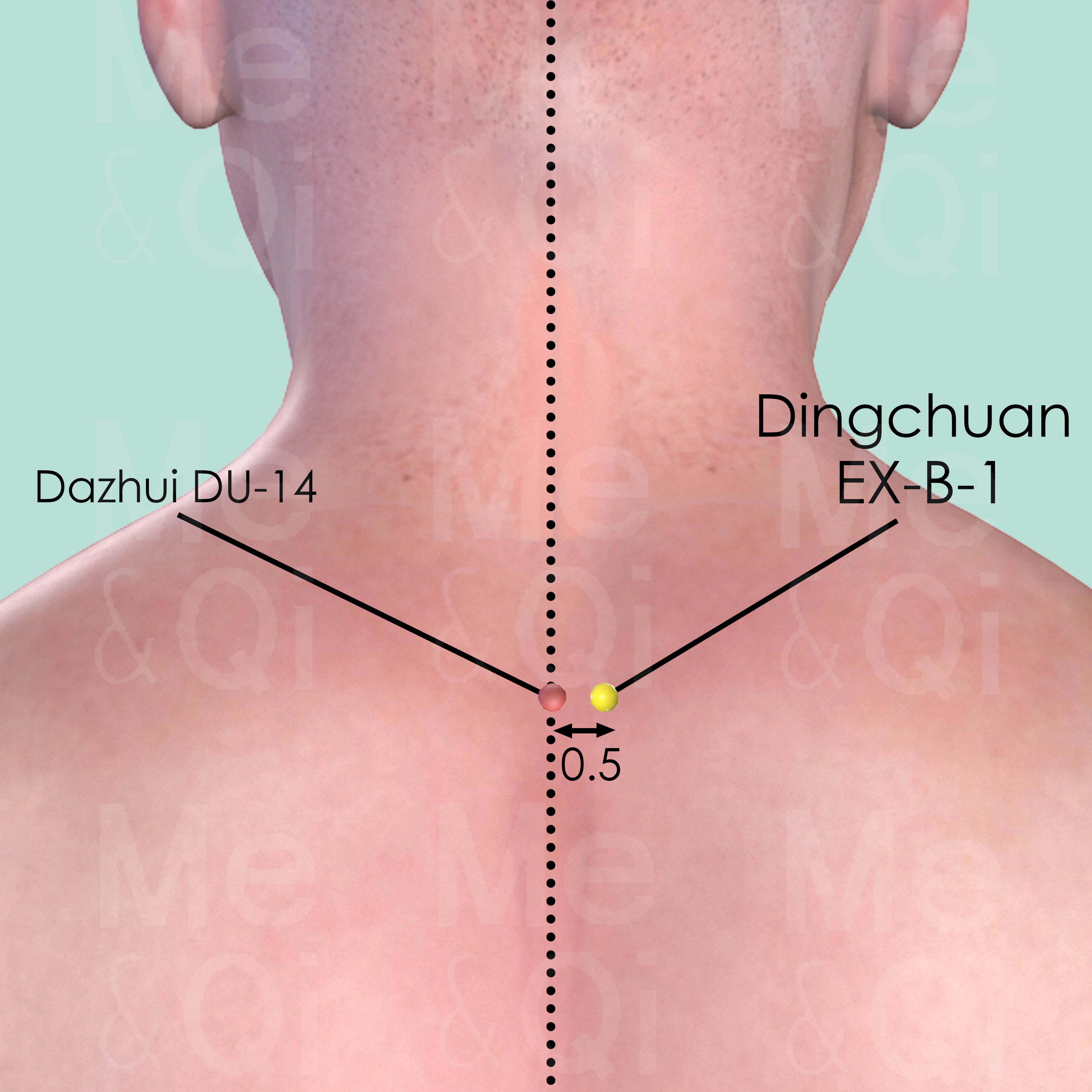
Dingchuan EX-B-1
0.5 cun lateral to the lower border of the spinous process of the 7th cervical vertebra (C7).
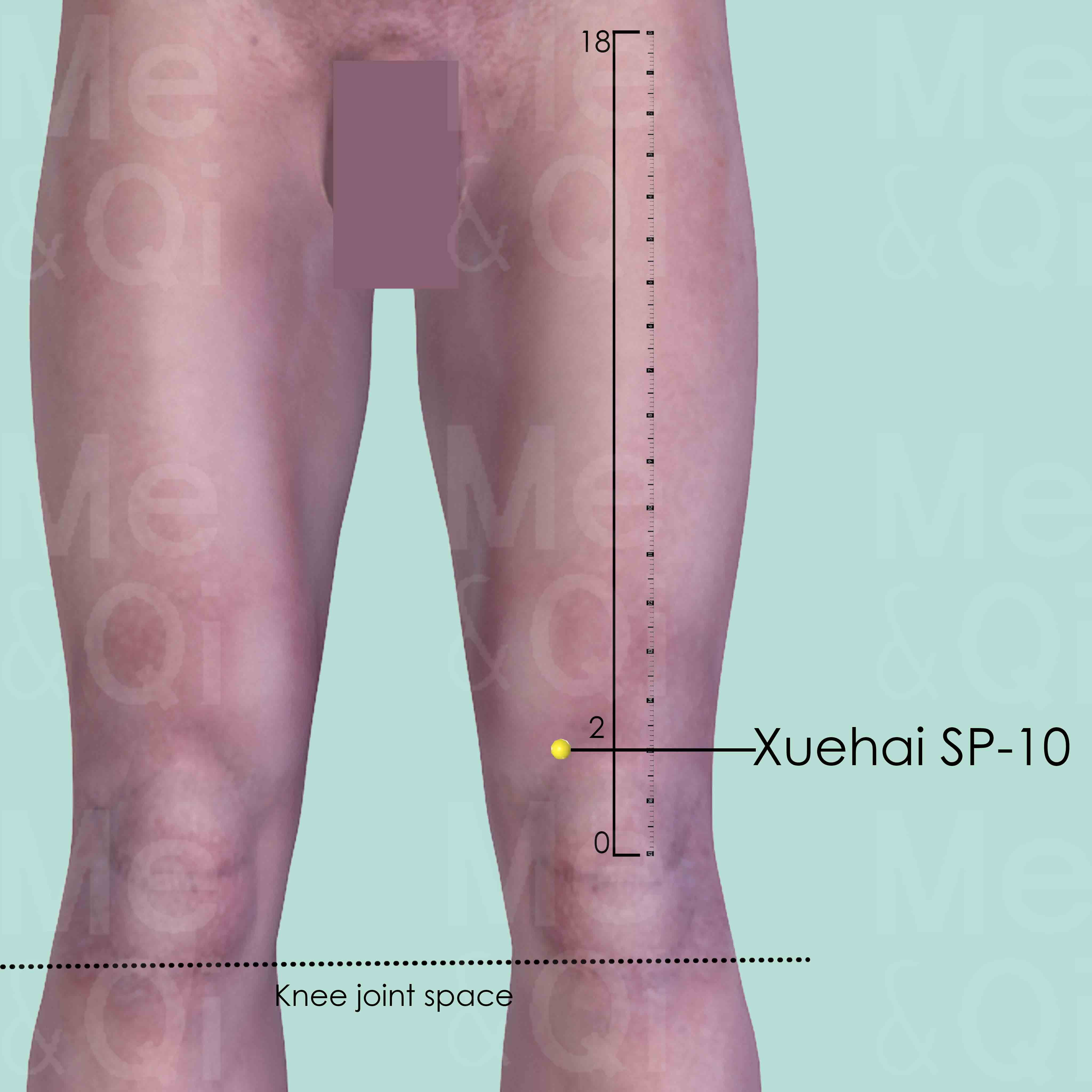
Xuehai SP-10
When knee is flexed, Xuehai SP-10 is 2 cun above the medial upper border of the patella, in a depression on the vastus medialis muscle.

